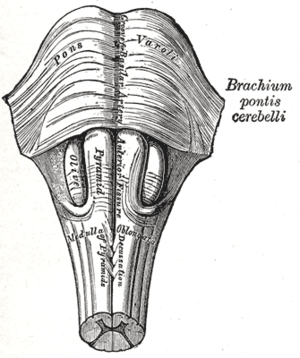Babinski–Nageotte syndrome
Babinski–Nageotte syndrome is an alternating brainstem syndrome. It occurs when there is damage to the dorsolateral or posterior lateral medulla oblongata, likely syphilitic in origin.[1] Hence it is also called the alternating medulla oblongata syndrome.
| Babinski–Nageotte syndrome | |
|---|---|
| Other names | Babinski syndrome or Hemimedullary syndrome |
 | |
| Medulla oblongata anterior view | |
| Specialty | Neurology |
The rare[2] disorder is caused by damage to a part of the brain (medullobulbar transitional area) which causes a variety of neurological symptoms, some of which affect only one side of the body. Symptoms include ipsilateral (same side) cerebellar ataxia, sensory deficits of the face, and Horner's syndrome, along with weakness and loss of sensation on the contralateral (opposite side) of the body.[3]
It was first described in 1902 and later named after the neurologists who initially investigated it, Joseph Babinski and Jean Nageotte.[4]
References
- Poirier, Jacques Philippon, Jacques (2009). Joseph Babinski : a biography. Oxford: Oxford University Press. p. 204. ISBN 9780195369755.
- Fisher, Marc, ed. (2008). Stroke (1 publ. ed.). Edinburgh: Elsevier. p. 541. ISBN 9780444520043.
- al.], Andrew J. Larner ... [et (2011). A-Z of neurological practice a guide to clinical neurology (2nd ed.). Dordrecht: Springer. p. 84. ISBN 9781848829947.
- "Babinski-Nageotte syndrome". Who Named It?. Retrieved 2010-12-30.